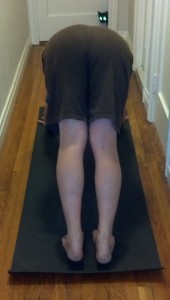 I spend a lot of time in adho mukha svanasana, or downward dog. When I am there I am trying to recreate an image of standing, or tadasana. Anatomical neutral is the place where the body is standing at rest. For me, this means that the feet are parallel as close together as comfortable. For some reason many people issue a standard instruction of feet placed hip distance apart. This doesn’t make any sense to me as there is a fairly specific alignment of the leg bones. The arrangement of the legs is as follows—the shins should be parallel to each other with the heels in line with the sit bones and when the shins reach the knee, the femur bones angle outward to connect to the pelvis.
I spend a lot of time in adho mukha svanasana, or downward dog. When I am there I am trying to recreate an image of standing, or tadasana. Anatomical neutral is the place where the body is standing at rest. For me, this means that the feet are parallel as close together as comfortable. For some reason many people issue a standard instruction of feet placed hip distance apart. This doesn’t make any sense to me as there is a fairly specific alignment of the leg bones. The arrangement of the legs is as follows—the shins should be parallel to each other with the heels in line with the sit bones and when the shins reach the knee, the femur bones angle outward to connect to the pelvis.
This is one hallmark of being human. Our legs track directly beneath our hips in order for us to walk forward on two legs. So when teaching yoga I try to bring the legs of students as close together as possible when doing things like Tadasana, wheel pose, and for the sake of this post—down dog or adho mukha svanasana.
The alignment of the bones is one reason to keep the legs fairly close together but I also think there is benefit to the inner thigh muscles and the deep core muscles of the trunk. The closer the legs are together in these poses the easier it will be to access the inner thighs and core. There are reasons why some people should keep the legs wider apart. Pregnant women are free to widen the legs and there are some people who are so tight in the hips that bringing the feet too close together too soon bows out the knees.
For the sake of this down dog discussion we are going to keep the feet as close together as possible and parallel. I prefer a long adho mukha svanasana so even though my hamstrings are loose my hands and feet are far enough apart to keep my heels off the ground. My standard instruction for the arrangement of the feet is that the big toes should be parallel and you shouldn’t be able to see your heels as you look between your feet.
If you lie down on your back and put your legs straight up in the air there is a lot of information available concerning what your legs might do in down dog. If the hips hamstrings are open and long you will be able to hold your legs at a right angle to the floor and ideally have a small arch in the lower back. If the hips and hamstrings are restricted you will be able to see how that manifests in the difficulty to be found when trying to straighten the legs.
While you are at it, look at your feet (I do this a lot)—the imbalance of the inner and outer leg often shows a tendency for the outer foot to curve up towards the ceiling more than the inner foot. If that is your story try to get your feet flush to the ceiling as if you were standing on a floor. The effort to do that mirrors some of the work you will need to do in down dog.
The kneecap should track directly over the center of the ankle joint and when you straighten the leg to go deeper the kneecaps should not roll towards each other. If the knees roll in that is a signal that you might be hyperextending your knee. This is one of the classic problems I see in many down dogs—instead of lengthening down the entire leg, which would keep the kneecap tracked in line with the ankle; students tend to push the calf backwards into hyperextension which rolls the kneecap inward.
One way to feel what I think the leg should do in down dog is to bend the knees a couple of inches keeping the kneecap aligned over center. Then from both the inner heel and the inner thighs, straighten the leg without letting the kneecap roll in. This should take you into a calf stretch to go with the hamstring stretch that would be ideal in this pose. Instead there is often a lot of work going on in places that don’t need it.
To reiterate today’s tips for the legs in down dog:
- Keep the feet as close together as comfortable or a little closer.
- You shouldn’t be able to see your heels if your feet are parallel.
- Track the center of the kneecaps over the center of the ankle joints.
- Stretch the whole back of the leg not just the hamstrings.
***
